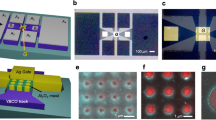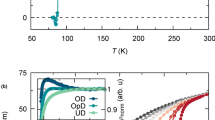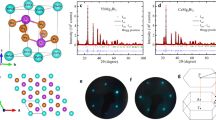Abstract
Central to the understanding of high-temperature superconductivity is the evolution of the electronic structure as doping alters the density of charge carriers in the CuO2 planes. Superconductivity emerges along the path from a normal metal on the overdoped side to an antiferromagnetic insulator on the underdoped side. This path also exhibits a severe disruption of the overdoped normal metal’s Fermi surface1,2,3. Angle-resolved photoemission spectroscopy (ARPES) on the surfaces of easily cleaved materials such as Bi2Sr2CaCu2O8+δ shows that in zero magnetic field the Fermi surface breaks up into disconnected arcs4,5,6. However, in high magnetic field, quantum oscillations7 at low temperatures in YBa2Cu3O6.5 indicate the existence of small Fermi surface pockets8,9,10,11,12,13,14,15,16,17,18. Reconciling these two phenomena through ARPES studies of YBa2Cu3O7−δ (YBCO) has been hampered by the surface sensitivity of the technique19,20,21. Here, we show that this difficulty stems from the polarity and resulting self-doping of the YBCO surface. Through in situ deposition of potassium atoms on cleaved YBCO, we can continuously control the surface doping and follow the evolution of the Fermi surface from the overdoped to the underdoped regime. The present approach opens the door to systematic studies of high-temperature superconductors, such as creating new electron-doped superconductors from insulating parent compounds.
This is a preview of subscription content, access via your institution
Access options
Subscribe to this journal
Receive 12 print issues and online access
$259.00 per year
only $21.58 per issue
Buy this article
- Purchase on SpringerLink
- Instant access to full article PDF
Prices may be subject to local taxes which are calculated during checkout




Similar content being viewed by others
References
Hussey, N. E., Abdel-Jawad, M., Carrington, A., Mackenzie, A. P. & Balicas, L. A coherent three-dimensional Fermi surface in a high-transition-temperature superconductor. Nature 425, 814–817 (2003).
Platé, M. et al. Fermi surface and quasiparticle excitations of overdoped Tl2Ba2CuO6+δ by ARPES. Phys. Rev. Lett. 95, 077001 (2005).
Peets, D. C. et al. Tl2Ba2CuO6+δ brings spectroscopic probes deep into the overdoped regime of the high-Tc cuprates. New J. Phys. 9, 1–32 (2007).
Norman, M. R. et al. Destruction of the Fermi surface in underdoped high-Tc superconductors. Nature 392, 157–160 (1998).
Kanigel, A. et al. Evolution of the pseudogap from Fermi arcs to the nodal liquid. Nature Phys. 2, 447–451 (2006).
Shen, K. M. et al. Nodal quasiparticles and antinodal charge ordering in Ca2−xNaxCuO2Cl2 . Science 307, 901–904 (2005).
Doiron-Leyraud, N. et al. Quantum oscillations and the Fermi surface in an underdoped high-Tc superconductor. Nature 447, 565–568 (2007).
Balakirev, F. F. et al. Fermi surface reconstruction at optimum doping in high-Tc superconductors. Preprint at <http://arxiv.org/abs/0710.4612> (2007).
LeBoeuf, D. et al. Electron pockets in the Fermi surface of hole-doped high-Tc superconductors. Nature 450, 533–536 (2007).
Jaudet, C. et al. de Haas-van Alphen oscillations in the underdoped cuprate YBa2Cu3O6.5 . Phys. Rev. Lett. 100, 187005 (2008).
Elfimov, I. S., Sawatzky, G. A. & Damascelli, A. Fermi pockets and correlation effects in underdoped YBa2Cu3O6.5 . Phys. Rev. B 77, 060504(R) (2008).
Carrington, A. & Yelland, E. A. Band-structure calculations of Fermi-surface pockets in ortho-II YBa2Cu3O6.5 . Phys. Rev. B 76, 140508(R) (2007).
Harrison, N., McDonald, R. D. & Singleton, J. Cuprate Fermi orbits and Fermi arcs: The effect of short-range antiferromagnetic order. Phys. Rev. Lett. 99, 206406 (2007).
Chen, W.-Q., Yang, K.-Y., Rice, T. M. & Zhang, F. C. Quantum oscillations in magnetic field induced antiferromagnetic phase of underdoped cuprates : Application to ortho-II YBa2Cu3O6.5 . Europhys. Lett. 82, 17004 (2008).
Millis, A. J. & Norman, M. Antiphase stripe order as the origin of electron pockets observed in 1/8-hole-doped cuprates. Phys. Rev. B 76, 220503(R) (2007).
Chakravarty, S. & Kee, H.-Y. Fermi pockets and quantum oscillations of the Hall coefficient in high temperature superconductors. Preprint at <http://arxiv.org/abs/0710.0608> (2007).
Alexandrov, A. S. Theory of quantum magneto-oscillations in underdoped cuprate superconductors. J. Phys. Condens. Matter 20, 192202 (2008).
Melikyan, A. & Vafek, O. Quantum oscillations in the mixed state of d-wave superconductor. Preprint at <http://arxiv.org/abs/0711.0776> (2007).
Schabel, M. C. et al. Angle-resolved photoemission on untwinned YBa2Cu3O6.95. I. Electronic structure and dispersion relations of surface and bulk bands. Phys. Rev. B 57, 6090–6106 (1998).
Lu, D. H. et al. Superconducting gap and strong in-plane anisotropy in untwinned YBa2Cu3O7−d . Phys. Rev. Lett. 86, 4370–4373 (2001).
Zabolotnyy, V. B. et al. Momentum and temperature dependence of renormalization effects in the high-temperature superconductor YBa2Cu3O7−d . Phys. Rev. B 76, 064519 (2007).
Derro, D. J. et al. Nanoscale one-dimensional scattering resonances in the CuO chains of YBa2Cu3O6+x . Phys. Rev. Lett. 88, 097002 (2002).
Liang, R., Bonn, D. A. & Hardy, W. N. Evaluation of CuO2 plane hole doping in YBa2Cu3O6+x single crystals. Phys. Rev. B 73, 180505 (2006).
Kondo, T. et al. Dual character of the electronic structure of YBa2Cu4O8: The conduction bands of CuO2 planes and CuO chains. Phys. Rev. Lett. 98, 157002 (2007).
Hesper, R., Tjeng, L. H., Heeres, A. & Sawatzky, G. A. Photoemission evidence of electronic stabilization of polar surfaces in K3C60 . Phys. Rev. B 62, 16046–16055 (2000).
Sushkov, O. P., Sawatzky, G. A., Eder, R. & Eskes, H. Hole photoproduction in insulating copper oxide. Phys. Rev. B 56, 11769–11776 (1997).
Eskes, H. & Eder, R. Hubbard model versus t–J model: The one-particle spectrum. Phys. Rev. B 54, 14226–14229 (1996).
Liang, R., Bonn, D. A. & Hardy, W. N. Preparation and x-ray characterization of highly ordered ortho-II phase YBa2Cu3O6.50 single crystals. Physica C 336, 57–62 (2000).
Damascelli, A. et al. Fermi surface, surface states, and surface reconstruction in Sr2RuO4 . Phys. Rev. Lett. 85, 5194–5197 (2000).
Ohta, T., Bostwick, A., Seyller, T., Horn, K. & Rotenberg, E. Controlling the electronic structure of bilayer graphene. Science 313, 951–954 (2006).
Acknowledgements
We gratefully acknowledge J. van den Brink for insightful discussions. This work was supported by the Alfred P. Sloan Foundation (A.D.), an ALS Doctoral Fellowship (M.A.H.), the CRC Program (A.D. and G.A.S), NSERC, CFI, CIFAR Quantum Materials and BCSI. The Advanced Light Source is supported by the Director, Office of Science, Office of Basic Energy Sciences, of the US Department of Energy under Contract No. DE-AC02-05CH11231.
Author information
Authors and Affiliations
Corresponding author
Supplementary information
Supplementary Information
Supplementary Information and Supplementary Figure 1 (PDF 220 kb)
Rights and permissions
About this article
Cite this article
Hossain, M., Mottershead, J., Fournier, D. et al. In situ doping control of the surface of high-temperature superconductors. Nature Phys 4, 527–531 (2008). https://doi.org/10.1038/nphys998
Received:
Accepted:
Published:
Issue date:
DOI: https://doi.org/10.1038/nphys998
This article is cited by
-
Investigating the Cuprates as a platform for high-order Van Hove singularities and flat-band physics
Communications Physics (2023)
-
Unveiling phase diagram of the lightly doped high-Tc cuprate superconductors with disorder removed
Nature Communications (2023)
-
Giant valley-Zeeman coupling in the surface layer of an intercalated transition metal dichalcogenide
Nature Materials (2023)
-
ARPES Study of Localized Charge Carriers in Y0.9Ca0.1Ba2Cu3O6.8 High-Temperature Superconductor
Journal of Superconductivity and Novel Magnetism (2023)
-
High-T\(_c\) Cuprates: a Story of Two Electronic Subsystems
Journal of Superconductivity and Novel Magnetism (2022)



